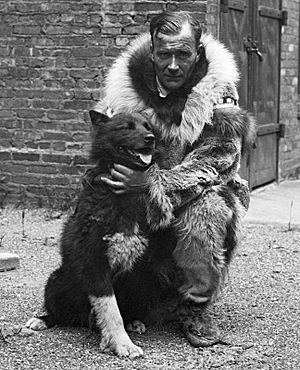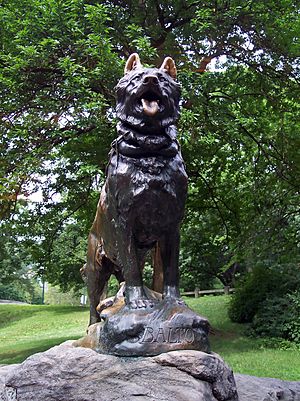Balto facts for kids

Balto with Gunnar Kaasen, his musher in the 1925 Serum Run.
|
|
| Species | Canis lupus familiaris |
|---|---|
| Breed | Siberian Husky |
| Sex | Male |
| Born | 1919 Nome, Territory of Alaska |
| Died | March 14, 1933 (aged 13–14) Cleveland, Ohio, United States |
| Resting place | Cleveland Museum of Natural History |
| Nation from | United States of America (Territory of Alaska) |
| Occupation | Sled dog |
| Known for | 1925 serum run to Nome |
| Owner | Leonhard Seppala |
| Appearance | Black with white "socks", "bib", and partial white markings on belly and tip of the muzzle, which advanced with age (including white markings around the eyes when he was old). Eyes were dark brown. |
| Named after | Samuel Balto |
Balto (1919 – March 14, 1933) was a Siberian Husky and sled dog belonging to musher and breeder Leonhard Seppala. He achieved fame when he led a team of sled dogs driven by Gunnar Kaasen on the final leg of the 1925 serum run to Nome, in which diphtheria antitoxin was transported from Anchorage, Alaska, to Nenana, Alaska, by train and then to Nome by dog sled to combat an outbreak of the disease.
Balto lived in ease at Cleveland Zoo until his death on March 14, 1933, at the age of 14. Following his death, his body was mounted and displayed in the Cleveland Museum of Natural History, where it remains today.
1925 serum run
In January 1925 doctors realized that a potentially deadly diphtheria epidemic was poised to sweep through the young people of Nome, Alaska. The only serum that could stop the outbreak was in Anchorage, Alaska. The engine of the only aircraft that could quickly deliver the medicine was frozen and would not start. After considering all the alternatives, officials decided to move the treatment via multiple dog sled teams. The serum was transported by train from Anchorage to Nenana, where the first musher embarked as part of a relay aimed at delivering the serum to Nome. More than 20 mushers took part, facing a blizzard with −23 °F (−31 °C) temperatures and strong winds. News coverage of the event was worldwide.
On February 2, 1925, the Norwegian Gunnar Kaasen, a family friend of Leonhard Seppala driving a team of Seppala's dogs which he had left behind in case they would be needed, led by Fox and including Balto among others, was handed off the serum package by Charlie Olson in Bluff. They arrived in Port Safety shortly thereafter, where the final leg of the relay was to begin. The last team and its driver, Ed Rohn, had believed Kaasen and the relay were halted in nearby Solomon due to inclement weather, and so were asleep when Kaasen and Balto made it to this final relay point – Kaasen decided to continue on, in order to save time it would take to change sleds and hitch up a new team. He traveled the remaining 25 miles (40 km) to Nome and arrived at Front Street at 5:30 a.m. All ampules of the antitoxin were intact, and Kaasen handed them over to be thawed for use by mid-day.
Aftermath
Considerable controversy surrounded Balto's use as a lead dog on Kaasen's team as well, including many mushers and others at the time doubting the claims that he truly led the team, based primarily on the dog's track record; no records exist of Seppala ever having used him as a leader in runs or races prior to 1925, and Seppala himself stated Balto "was never in a winning team", and was a "scrub dog". Because the pictures and video of Kaasen and Balto taken in Nome were recreated hours after their arrival once the sun had risen, speculation still exists as to whether Balto's position as lead dog was genuine, or was staged or exaggerated for media purposes due to Balto being a more newsworthy name than Fox. While historians note that it is possible Balto led Kaasen's team, he at most likely ran co-lead with Fox, rather than running single-lead by himself as is commonly held by the media. Many decorated mushers and others in the surrounding area also believed, including Rohn based on conversations the two men had before leaving Nome, that Kaasen's decision to not wake Rohn at Port Safety was motivated by a desire to grab the glory for himself.
After the mission's success, Balto and Kaasen became celebrities to Seppala's great displeasure, as Togo had gone through by far the longest and most dangerous part of the serum run. Seppala stated:
I hope I shall never be the man to take away credit from any dog or driver who participated in that run. We all did our best. But when the country was roused to enthusiasm over the serum run driver, I resented the statue to Balto, for if any dog deserved special mention it was Togo. [...] At the time I left [for the run] I never dreamed that anyone could consider these dogs [the second string] fit to drive even in a short relay. [...] As to the leader, it was up to the driver who happened to be selected to choose any dog he liked, and he chose Balto.
Balto is to this day still more famous to the general public despite there being many misconceptions about his and Kaasen's fame. The contribution of Alaska Natives, whose teams "covered nearly two thirds of the run," is also heavily obscured. According to The New York Times, "the overlooking of Togo still infuriates mushers".
A statue of Balto, sculpted by Frederick Roth, was erected in New York City's Central Park on December 17, 1925, ten months after Balto's arrival in Nome. Balto himself was present for the monument's unveiling. The statue is located on the main path leading north from the Tisch Children's Zoo. In front of the statue a low-relief slate plaque depicts Balto's sled team, and bears the following inscription:
Dedicated to the indomitable spirit of the sled dogs that relayed antitoxin six hundred miles over rough ice, across treacherous waters, through Arctic blizzards from Nenana to the relief of stricken Nome in the Winter of 1925.
Endurance · Fidelity · Intelligence
Balto could not be used for breeding because he was neutered at a young age, so he was relegated to the vaudeville circuit along with his team. When Kaasen wished to return home to Alaska, the dogs were sold to the highest bidder by the company who sponsored his tour. The dogs ended up chained in a small area in a novelty museum and freak show in Los Angeles. While visiting Los Angeles, George Kimble, a former prizefighter turned businessman from Cleveland, was shocked to discover the dogs were unhealthy and badly treated. Kimble worked together with the newspaper the Plain Dealer to bring Balto and his team to Cleveland, Ohio. On March 19, 1927, Balto and six companions were brought to Cleveland and given a hero's welcome in a triumphant parade. The dogs were then taken to the Brookside Zoo (now the Cleveland Metroparks Zoo).

After Balto died in 1933, his remains were mounted by a taxidermist and donated to the Cleveland Museum of Natural History. In 1998, the Alaska Legislature passed HJR 62 - "Bring Back Balto" resolution. The Cleveland Museum of Natural History declined to return Balto; however, in October 1998, Balto left for a five-month stay at the Anchorage Museum of History and Art, which drew record crowds. Balto was part of another exhibit at the Anchorage Museum of History and Art in 2017.
See also
 In Spanish: Balto para niños
In Spanish: Balto para niños
- Iditarod Trail
- Northern (genre)
- Hachikō
- Togo (dog)
- List of individual dogs


